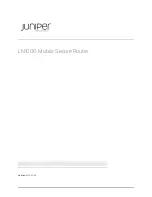
11-15
Cisco ME 3400 Ethernet Access Switch Software Configuration Guide
OL-9639-07
Chapter 11 Configuring VLANs
Configuring VLAN Trunks
You can configure a trunk on a single Ethernet interface or on an EtherChannel bundle. For more
information about EtherChannels, see
Chapter 34, “Configuring EtherChannels and Link-State
Tracking.”
Ethernet interfaces support different trunking modes (see
Table 11-4
). You can set an interface as
trunking or nontrunking.
•
If you do not intend to trunk across links, use the
switchport mode access
interface configuration
command to disable trunking.
•
To enable trunking, use the
switchport mode trunk
interface configuration command to change the
interface to a trunk.
IEEE 802.1Q Configuration Considerations
The IEEE 802.1Q trunks impose these limitations on the trunking strategy for a network:
•
In a network of Cisco switches connected through IEEE 802.1Q trunks, the switches maintain one
spanning-tree instance for each VLAN allowed on the trunks. Non-Cisco devices might support one
spanning-tree instance for all VLANs.
When you connect a Cisco switch to a non-Cisco device through an IEEE 802.1Q trunk, the Cisco
switch combines the spanning-tree instance of the VLAN of the trunk with the spanning-tree
instance of the non-Cisco IEEE 802.1Q switch. However, spanning-tree information for each VLAN
is maintained by Cisco switches separated by a cloud of non-Cisco IEEE 802.1Q switches. The
non-Cisco IEEE 802.1Q cloud separating the Cisco switches is treated as a single trunk link between
the switches.
•
Make sure that the native VLAN for an IEEE 802.1Q trunk is the same on both ends of the trunk
link. If the native VLAN on one end of the trunk is different from the native VLAN on the other end,
spanning-tree loops might result.
Table 11-4
Layer 2 Interface Modes
Mode
Function
switchport mode access
Puts the interface (access port) into permanent nontrunking mode and negotiates to
convert the link into a nontrunk link. The interface becomes a nontrunk interface
regardless of whether or not the neighboring interface is a trunk interface. This is the
default mode.
switchport mode trunk
Puts the interface into permanent trunking mode and negotiates to convert the
neighboring link into a trunk link. The interface becomes a trunk interface even if the
neighboring interface is not a trunk interface.
switchport mode dot1q-tunnel
Configures the interface as a tunnel (nontrunking) port to be connected in an asymmetric
link with an IEEE 802.1Q trunk port. The IEEE 802.1Q tunneling is used to maintain
customer VLAN integrity across a service provider network. See
Chapter 13,
“Configuring IEEE 802.1Q Tunneling and Layer 2 Protocol Tunneling,”
for more
information on tunnel ports.
switchport mode private-vlan
Configure the interface as a private VLAN host or promiscuous port (only NNIs can be
configured as promiscuous ports). For information about private VLANs, see
Chapter 12,
“Configuring Private VLANs.”
Содержание ME 3400 Series
Страница 40: ...Contents xl Cisco ME 3400 Ethernet Access Switch Software Configuration Guide OL 9639 07 ...
Страница 44: ...xliv Cisco ME 3400 Ethernet Access Switch Software Configuration Guide OL 9639 07 Preface ...
Страница 1138: ...Index IN 52 Cisco ME 3400 Ethernet Access Switch Software Configuration Guide OL 9639 07 ...
















































